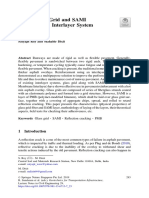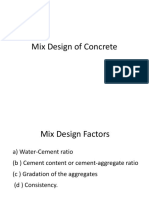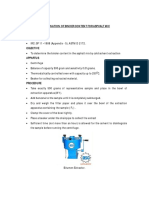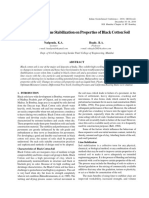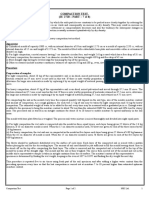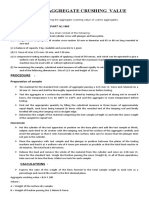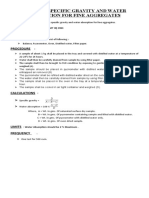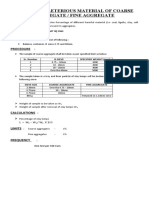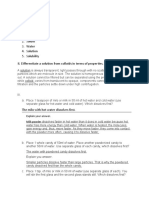Density For Soil by Sand Displacement Method: Scope Is Code Apparatus
Uploaded by
Mastani BajiraoDensity For Soil by Sand Displacement Method: Scope Is Code Apparatus
Uploaded by
Mastani BajiraoDENSITY FOR SOIL BY SAND DISPLACEMENT
METHOD
SCOPE : To determining the dry density of soil compacted in layers 150mm to 250mm thickness.
IS CODE : IS: 2720 (PART xxvii) 1974
APPARATUS :
Large sand pouring cylinder, tools for excavation holes, cylindrical calibrating container
(Dia -150mm, depth 175mm and 100mm dia, depth 150mm), Balance, plane surface (A
glass of 600 mm sq and 10 mm thick) metal container (To collect excavated soil), metal
tray (450mm sq and 50mm deep with 150mm ,100mm dia hole in the centre)
MATERIAL :
Clean uniformly graded natural sand passing 1.0mm and retained on 600µ.
PROCEDURE :
The pouring cylinder should be filled with a given initial wt. of sand (W1).
A volume of sand equivalent to that of excavated hole in the soil shall be allowed to run
and closed the shutter when no movement of sand takes place.
The sand that has filled the cone of the pouring cylinder shall collected and weighed
(W2).
Internal volume V in ml of calibrating container should be determined.
The calibrating container should stand on large tray and pouring cylinder placed on
top with constant wt of sand wt. the shutter of pouring cylinder opened and the sand
allowed to run out. When no further movement of sand takes place closed the
shutter the wt. of sand retain on pouring cylinder weighed (W 3).
The metal tray with centre hole shall be laid on prepared surface of soil to be tested.
The hole in the soil excavated using the hole in the tray as a pattern to the depth of
layer to be tested up to max. 250mm. the excavated soil weighed - Ww .The metal
tray removed and pouring cylinder placed over excavated hole.
The pouring cylinder filled with constant wt. of sand W1 and open the shutter to flow
the sand into the hole when no movement of sand takes place closed the shutter
and wt. taken – (W4)
CALCULATIONS :
The weight of sand in (Wa) gms required too fill the calibrating container
Wa = W1– W3 – W2
W1 = wt. of pouring cylinder and sand before pouring into calibrating container in gms.
W3 = wt. of cylinder with residual sand after pouring into calibrating container.
W2 = mean wt. of sand in cone in gms.
Wa
The bulk density of sand Уs = X 1000 kg/cum
V
V = volume of calibrating container in ml
The wt. of sand (Wb) in gms, required to fill the excavated hole shall be calculated from the the
following formula :
Wb = W1 – W4 – W2
W1 = wt. of cylinder and sand before pouring into hole in gms
W4 = wt. of cylinder and sand after pouring into hole and cone in gms
W2 = mean wt. in sand of cone in gms.
The bulk density
Ww
Уb = X У skg/ cum
Ws
Ww = wt. of soil excavated in gms.
Wb = wt. of sand required to fill the hole in gms
У s = bulk density of sand in kg/m3
100У b
Уd = kg /m3
100+ω
Wd
Уd = X У s kg/m 3
Wb
𝛚 = water content of the soil in percent
Wd= wt. of dry soil from the hole in gms
Wb = wt. of sand required to fill the hole in gms
LIMITS :
TYPE OF MATERIAL LIMIT
MOORUM / RED BAJRI / GRAVEL AT LEAST 98% OF THE
MAX. DRY DENSITY
EARTH WORK ON EMBANKEMENT AT LEAST 98% OF THE
MAX. DRY DENSITY
FREQUENCY :
TYPE OF MATERIAL FREQUENCY
MOORUM / RED BAJRI / GRAVEL 2 TEST PER 3000 / CUM
EARTH WORK ON EMBANKEMENT 2 TEST PER 3000 / CUM OF
SOIL
You might also like
- Slurry Transport Using Centrifugal Pumps (4th Edition) 2023100% (1)Slurry Transport Using Centrifugal Pumps (4th Edition) 2023494 pages
- Minimise Amine Losses in Gas and Liquid Treating100% (3)Minimise Amine Losses in Gas and Liquid Treating10 pages
- Determination of Permeability of Soil by Falling Head MethodNo ratings yetDetermination of Permeability of Soil by Falling Head Method3 pages
- Experiment No. Name of The Experiment: Aggregate Impact Test AIM OF THE EXPERIMENT: To Determine The Aggregate Impact Value ofNo ratings yetExperiment No. Name of The Experiment: Aggregate Impact Test AIM OF THE EXPERIMENT: To Determine The Aggregate Impact Value of4 pages
- Determination of Flakiness and Elongation Index For The Given Aggregate Sample.No ratings yetDetermination of Flakiness and Elongation Index For The Given Aggregate Sample.4 pages
- Determination of Relative Density or Density Index of Sand (Is-2720-Part-15)No ratings yetDetermination of Relative Density or Density Index of Sand (Is-2720-Part-15)3 pages
- Concrete Mix Design and Casting of Sample For Different TestNo ratings yetConcrete Mix Design and Casting of Sample For Different Test4 pages
- MDD & OMC Test of Soil Using Modified Proctor Test100% (1)MDD & OMC Test of Soil Using Modified Proctor Test2 pages
- 3.0 Determination of Liquid Limit Using The Cone PenetrometerNo ratings yet3.0 Determination of Liquid Limit Using The Cone Penetrometer10 pages
- Determination of Angularity Number For The Given Aggregate SampleNo ratings yetDetermination of Angularity Number For The Given Aggregate Sample4 pages
- Experiment No. 7: To Conduct The Rtfo Test On Asphalt: ObjectiveNo ratings yetExperiment No. 7: To Conduct The Rtfo Test On Asphalt: Objective3 pages
- Observation Sheet: Result of Aggregate Impact Value TestNo ratings yetObservation Sheet: Result of Aggregate Impact Value Test1 page
- Experiment-5 Flakiness Index (FI) Objective Theory: Minimum Mass of Test Portion0% (1)Experiment-5 Flakiness Index (FI) Objective Theory: Minimum Mass of Test Portion1 page
- Determination of The Permeability of Granular Soil100% (1)Determination of The Permeability of Granular Soil19 pages
- Tension Test On Steel Rod - Procedure and ResultsNo ratings yetTension Test On Steel Rod - Procedure and Results6 pages
- Tittle: Field Density Test. Scope: To Determine Density of Soil at The Field Itself ApparatusNo ratings yetTittle: Field Density Test. Scope: To Determine Density of Soil at The Field Itself Apparatus6 pages
- Soundness Test of Cement (Autoclave Method)100% (1)Soundness Test of Cement (Autoclave Method)3 pages
- Mohammad Yunus Salehi I11007770 Experiment 4: Unconfined Compression Test75% (4)Mohammad Yunus Salehi I11007770 Experiment 4: Unconfined Compression Test6 pages
- Procedure of Penetration Test On BitumenNo ratings yetProcedure of Penetration Test On Bitumen3 pages
- Compaction Test. (IS: 2720 - PART - 7 & 8)No ratings yetCompaction Test. (IS: 2720 - PART - 7 & 8)2 pages
- CE 328: Transportation Engineering Lab Experiment No. 9 - Spot Speed StudyNo ratings yetCE 328: Transportation Engineering Lab Experiment No. 9 - Spot Speed Study20 pages
- Numerical Methods and Implementation in Geotechnical Engineering – Part 1From EverandNumerical Methods and Implementation in Geotechnical Engineering – Part 1No ratings yet
- Field Density Test: Sand Replacement Method ObjectiveNo ratings yetField Density Test: Sand Replacement Method Objective5 pages
- Determination of In-Situ Unit Weight of Soil: Experiment No 2 & 3 Soil Mechanics Laboratory CE PC 594100% (1)Determination of In-Situ Unit Weight of Soil: Experiment No 2 & 3 Soil Mechanics Laboratory CE PC 59430 pages
- Determination of Field Density of Soil by Sand Replacement MethodNo ratings yetDetermination of Field Density of Soil by Sand Replacement Method4 pages
- Field Density by Sand Replacement MethodNo ratings yetField Density by Sand Replacement Method4 pages
- Name of Work Contractor CA No.::: Resurfacing of Runway and Allied Works at AF Station Panagarh M/s PNC Infratech LTD CE (AF) SZ/PAN/18 OF 2013-14No ratings yetName of Work Contractor CA No.::: Resurfacing of Runway and Allied Works at AF Station Panagarh M/s PNC Infratech LTD CE (AF) SZ/PAN/18 OF 2013-1416 pages
- Aggregate Crushing Value Test For AggregateNo ratings yetAggregate Crushing Value Test For Aggregate2 pages
- Determination of Specific Gravity and Water Absorption For Fine AggregatesNo ratings yetDetermination of Specific Gravity and Water Absorption For Fine Aggregates1 page
- Los Angeles Abrasion Value Test For AggregateNo ratings yetLos Angeles Abrasion Value Test For Aggregate2 pages
- Aerodrome Design Manual: Taxiways, Aprons and Holding BaysNo ratings yetAerodrome Design Manual: Taxiways, Aprons and Holding Bays68 pages
- Is 2386 - 1963 Part 8 Test For AggregatesNo ratings yetIs 2386 - 1963 Part 8 Test For Aggregates24 pages
- IRC 44-2008 Cement Concrete Design Mix For PavementNo ratings yetIRC 44-2008 Cement Concrete Design Mix For Pavement28 pages
- M6 Chopped Strand Mat: Product DescriptionNo ratings yetM6 Chopped Strand Mat: Product Description3 pages
- CST - Protocol - Cell Signaling TechnologyNo ratings yetCST - Protocol - Cell Signaling Technology2 pages
- Adhesive Performance of A Multi-Mode Adhesive System - 1-Year in Vitro Study Lorenzo Breschi DNo ratings yetAdhesive Performance of A Multi-Mode Adhesive System - 1-Year in Vitro Study Lorenzo Breschi D10 pages
- Fosroc Dekguard EP302: Water Based, Epoxy Resin Primer For Dekguard PUNo ratings yetFosroc Dekguard EP302: Water Based, Epoxy Resin Primer For Dekguard PU2 pages
- High-Performance Polymers For Engineering-Based CompositesNo ratings yetHigh-Performance Polymers For Engineering-Based Composites393 pages
- COA Apple Cider Vinegar Powder 10% WellgreenNo ratings yetCOA Apple Cider Vinegar Powder 10% Wellgreen1 page
- Research Progress On The Characterization and Repair of Graphene DefectsNo ratings yetResearch Progress On The Characterization and Repair of Graphene Defects12 pages
- Biochemical Properties of Whole and Degermed Maize Flours During StorageNo ratings yetBiochemical Properties of Whole and Degermed Maize Flours During Storage6 pages
- Classification of Air Cleanliness by Particle Concentration (ISO 14644-1)No ratings yetClassification of Air Cleanliness by Particle Concentration (ISO 14644-1)2 pages
- 2024 PUC II Chemistry Key Answers and QPNo ratings yet2024 PUC II Chemistry Key Answers and QP46 pages
- International Equations For The Saturation Properties of Ordinary Water Substance-2No ratings yetInternational Equations For The Saturation Properties of Ordinary Water Substance-210 pages
- Chemical Bonds and Molecular Shape Summary PDFNo ratings yetChemical Bonds and Molecular Shape Summary PDF4 pages
- Safety Data Sheet: SECTION 1: Identification of The Substance/mixture and of The Company/undertakingNo ratings yetSafety Data Sheet: SECTION 1: Identification of The Substance/mixture and of The Company/undertaking9 pages
- Gold Refining Forum Handbook Vol 2 (6-24-09)86% (7)Gold Refining Forum Handbook Vol 2 (6-24-09)72 pages


